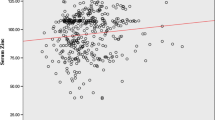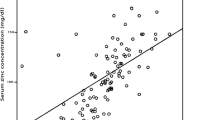Abstract
It has been suggested that mood disorders and depressive status may be accompanied by lowered zinc status in the body, and adequate consumption of zinc increases a general perceived well-being. The main objective of this study was to assess the correlation between serum zinc concentrations and dietary zinc intakes with depression scores in university female students. In the first phase, Beck's depression questionnaire was applied in a random sampling of 308 selected 20–25-year-old female students (one third of total students in Ahvaz Jondi-Shapour University of Medical Sciences Golestan dormitories) to assess the major depressive disorder (MDD) scales. Then, in the second phase, 23 students who identified as having moderate and severe depression were selected as the case group, and 23 healthy age matched were chosen as the controls. Each of them completed a 12-item semiquantitative food frequency questionnaire containing the main food sources of zinc in the usual dietary patterns and also a 24-h food recall questionnaire to assure the daily zinc intakes. Daily zinc intakes were obtained by multiplying each portion size by its zinc content using food tables. A 5-ml blood sample was taken for further serum zinc status using flame atomic absorption spectrophotometry technique. Pearson's r was used to show the correlation between quantitative variables. Both daily zinc intake and serum zinc concentrations of MDD group were about two thirds of healthy index (p < 0.01). Depressed individuals used to eat lower servings of red meats and chicken as the main food sources of zinc in students' usual diets (p < 0.001). Consumption of other foods as the sources of zinc was not significantly different in two groups. A linear significant correlation between dietary zinc intakes and its serum levels was seen in samples (r = 0.62; p < 0.001) and MDD students (r = 0.55; p < 0.001). There was a linear inverse correlation between Beck questionnaire scores and serum zinc concentrations in all of the investigated students(r = -0.65; p < 0.001) and MDD girls (r = −0.71; p < 0.001). Beck questionnaire scores and diatary zinc intakes were also inversly correlated (r = −0.58; p < 0.001). However, no statistical correlation was seen between these two variables in MDD cases. In depressed female students, dietary zinc intake is correlated to its serum concentrations; however, the serum zinc levels are inversely correlated to depression scales. Consumption of the main dietary sources of zinc such as red meats and chicken should be encouraged in young depressed girls.





Similar content being viewed by others
References
Lecomte D, Fornes P (1998) Suicide among youth and young adults, 15 through 24 years of age. A report of 392 cases from Paris, 1989–1996. J Forensic Sci 43:946–948
Murray CJL, Lopez AD (1997) Global mortality, disability and the contribution of risk factors: global burden of disease study. Lancet 349:1436–1442
Frederickson CJ (1989) Neurobiology of zinc and zinc containing neurons. Int Rev Neurobiol 31:145–238
Takeda A (2000) Movement of zinc and its functional significance in the brain. Brain Res Bull 34:137–148
Vallee BL, Falchuk KH (1993) The biochemical basis of zinc physiology. Physiol Rev 73:79–118
Nowak G, Szewczyk B, Pilc A (2005) Zinc and depression. An update. Pharmacol Rep 57:713–718
Nowak G, Schlegel-Zawadzka M (1999) Alterations in serum and brain trace element levels after antidepressant treatment. Part I. Zinc Biol Trace Elem Res 67:85–92
Kessler RC (2003) Epidemiology of women and depression. J Affect Disord 74:5–13
Ministry of Health (2006). Study on micronutrients in Iran (iron, zinc, vitamin A, and vitamin D). (Summer), 114–120
Hirschfeld RM, Keller MB, Panico S, Arons BS, Barlow D, Davidoff F et al (1997) The national depressive and manic-depressive association consensus statement on the undertreatment of depression. JAMA 277:333–340
Cassano P, Fava M (2004) Tolerability issues during long-term treatment with antidepressants. Ann Clin Psychiatry 16:15–25
Simon GE, Fleck M, Lucas R, Bushnell DM (2004) Prevalence and predictors of depression treatment in an international primary care study. Am J Psychiatry 161:1626–1634
Fava M, Davidson KG (1996) Definition and epidemiology of treatment-resistant depression. Psychiatr Clin North Am 19:179–200
Prased AS (1967) Importance of zinc in human nutrition. Am J Clin Nutr 20:648–652
Beck AT, Steer RA (1993) Beck depression inventory manual. Guidford press, New York
Milne BD (1994) Trace elements. In: Burtis CA, Ashwood E (eds) Tietz textbook of clinical chemistry. W.B. Saunders Company Philadelphia, Pensylvania, pp 1333–1335
Huang EP (1997) Metal ions and synaptic transmission: think zinc. Proc Natl Acad Sci U S A 94:13386–13387
Solomons NW (1988) Zinc and copper. In: Shils ME, Young VR (eds) Modern nutrition in health and disease. Philadelphia Lea, Febiger, pp 238–262
Nowak G, Szewczyk B (2002) Mechanisms contributing to antidepressant zinc action. Pol J Pharmacol 54:587–592
Hansen CR Jr, Malecha M, Mackenzie TB, Kroll J (1983) Copper and zinc deficiencies in association with depression and neurological findings. Biol Psychiatry 18:395–401
McLoughlin IJ, Hodge JS (1990) Zinc in depressive disorder. Acta Psychiatr Scand 82:451–453
Bitanihirwe BK, Cunningham MG (2009) Zinc: the brain's dark horse. Synapse 63(11):1029–1049
Maes M, D'Haese PC, Scharpe S, D'Hondt P, Cosyns P, De Broe ME (1994) Hypozincemia in depression. J Affect Disord 31:135–140
Marcellini F, Giuli C, Papa R, Gagliardi C, Dedoussis G, Herbein G et al (2006) Zinc status, psychological and nutritional assessment in old people recruited in five European countries: Zincage study. Biogerontology 7:339–345
Nowak G, Siwek M, Dudek D, Ziêba A, Pilc A (2006) Effect of zinc supplementation on antidepressant therapy in unipolar depression: a preliminary placebo-controlled study. Pol J Pharmacol 55:1143–1147
Levenson CW (2006) Zinc: the new antidepressant? Nutr Rev 64:39–42
Sowa-Kućma M, Legutko B, Szewczyk B, Novak K, Znojek P, Poleszak E et al (2008) Antidepressant-like activity of zinc: further behavioral and molecular evidence. J Neural Transm 115(12):1621–1628
Bondar LM Wisner KL (2005) Nutrition and depression: implications for improving mental health among childbearing-aged. Women Biol Psychiatr 58:679–685
Acknowledgment
This research was an approved University Project no. U 86070 and its costs were covered by the United Nations University grant. The authors wish to appreciate senior nutrition students Miss S. Andayesh, Miss A. Raeisi, and personnels of Analytical Lab of Pharmacy School, Mrs. R Ebrahimi and Mrs. A Hosseini, for their kind cooperations.
Author information
Authors and Affiliations
Corresponding author
Rights and permissions
About this article
Cite this article
Amani, R., Saeidi, S., Nazari, Z. et al. Correlation Between Dietary Zinc Intakes and Its Serum Levels with Depression Scales in Young Female Students. Biol Trace Elem Res 137, 150–158 (2010). https://doi.org/10.1007/s12011-009-8572-x
Received:
Accepted:
Published:
Issue Date:
DOI: https://doi.org/10.1007/s12011-009-8572-x




